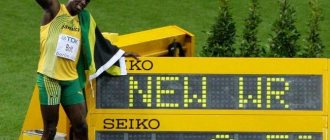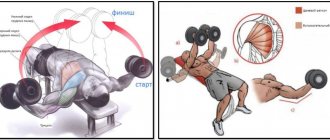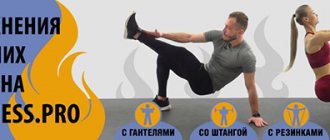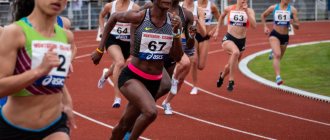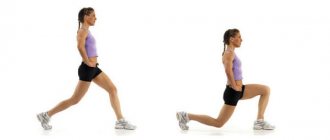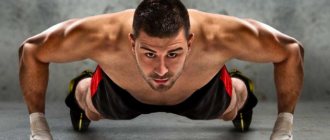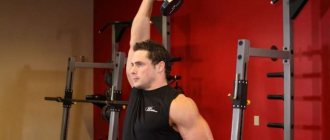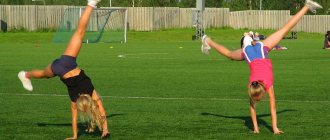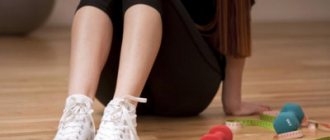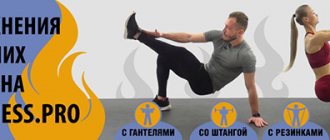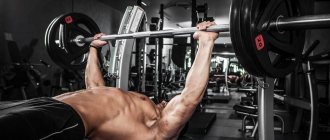Long jump: types and features
There are several variations of this exercise. In principle, they are almost the same. However, they have some features that you should be aware of. This approach will lead to precise, correct execution and maximum results.
Description of the exercise
The main role in performing the length exercise is played by:
- powerful repulsion;
- balance maintained during flight;
- correct landing.
This exercise has two options:
- Standing jump. To do this, you need to choose the right point for repulsion (start).
- From a running start.
To jump far, you need warm-up and preparation.
In warm-up gymnastics for jumping, the following is performed:
- squats;
- calf raises with a barbell;
- jumping onto any platform;
- goose-stepping;
- rotation of the feet 90 degrees in one direction and the other.
From a running start
The exercise begins with a run-up, but during the flight you can use bending methods - “scissors” or bent legs.
Also, the following features are characteristic of running long jumps:
- the accumulated speed must be maintained at the moment of repulsion;
- when pushing, you need to change the position of the body at the right angle;
- When landing, your feet must first be moved forward, and then only upward.
The above four points should be practiced as often as possible. To get maximum results, you need to choose the optimal distance for the run-up before taking off. This approach will help you gain maximum speed.
From place
The main feature of the exercise is to lift your legs off the ground with such force that it will help you cover as much distance as possible while flying.
Where to begin
Before starting classes, we will look at how to properly exercise with a skipping rope in order to lose weight and make all the muscles of the body more prominent.
Technique Tips
- Maintain your balance by looking forward.
- The body should be straight.
- Support your body weight on the balls of your feet.
- You need to jump so that the rope passes unhindered under your feet. (approximately 2.54 cm from the floor).
- Land on the balls of your feet as lightly as possible.
- Keep your elbows close to your sides.
- Your hands should be at an angle of 45 degrees in relation to your hips.
- When rotating the jump rope in your hands, only your wrists move in a circular motion.
- Don't sacrifice good technique for speed.
As for the load on the knees, I will only say one thing: if you do the jumps correctly, then the load on the knee joints will be minimal.
If you gradually complicate the exercises and jump from the ground to a height of 1.27 cm to 1.9 cm, the load on the knees will be less than when jogging, in addition to everything, the leg muscles will swing and strengthen.
As for the long term, regular training with a jump rope improves the functioning of the cardiovascular system, increases bone density, which reduces the risk of developing osteoporosis. This disease is especially relevant for women, since, according to statistics, the risk of developing the disease at the age of 70 is twice as high in women than in men.
This does not mean that jumping is absolutely safe; precautions should be observed always and everywhere, which will help avoid injuries in the future.
- First, wear sneakers with a stable, comfortable forefoot to protect the balls of your feet.
- Secondly, try not to jump on hard surfaces such as concrete or tiles. Instead, choose wooden or rubberized surfaces that absorb impact.
Choosing a jump rope
The correct length of the rope is very important for the successful execution of the exercise. How to choose the right length? To determine the required length, place your foot in the middle of the rope and lift the handles up on the sides of your body. If they are above the shoulders, then the length is too long. It should reach somewhere to the level of the armpits.
As you become more proficient, you can make the rope shorter, this will increase the speed of its rotation and improve your reflexes. You can cut off the excess or tie knots near the handles.
Jumping on two legs and running in place
Before moving on to more complex training methods, you must first master 2 basic exercise techniques. It would be even better to jump without a rope first. Don't think it's easy, because your goal is not speed, but technique.
To start, focus on developing synchronization and coordination. Try one jump. If it works, perform 5 jumps. As you improve your skill, continue to increase the number of jumps until you can perform 140 consecutive jumps. Exercise 5-10 minutes a day. After this, do some stretching exercises, especially your calves.
Standing long jump technique
Desire alone is not enough to learn how to jump effectively. First you need to learn the technique of long jump from a place or from a run.
Preparation before take-off
Taking the starting position is an important stage that allows you to concentrate and concentrate all your strength. Unlike the running long jump, here the initial phase is the starting line.
That is, it is necessary:
- with your feet shoulder-width apart, stand at the starting point;
- move your arms slightly behind your back (back), and lower them down with your elbows bent;
- bend the hip and knee joints at the level of the socks;
- fix your feet without lifting them off the ground.
Repulsion
The first repulsion should occur immediately after preparation. If you delay your readiness at this stage, then you will no longer be able to perform a long jump correctly from a standing position. Indeed, at this moment the torso begins inertial movement.
At the same time, during the shock period you need to have time to:
- make a sharp lunge with your hands in front of you;
- tighten the hip joints;
- straighten your legs (knees) at the joints;
- rise sharply from the ground.
Flight and landing
Correctly executed flight and landing will allow you to jump far.
During the flight you must:
- stretch your whole body to a straight line, smoothly straightening your knees;
- Before landing, lower your arms and bring your feet forward.
Contact with the surface should be easy and smooth for the jumper. For balance, knees are bent and arms are brought forward. This helps prevent injuries to the joints and their ligaments. When landing, you need to straighten up.
In addition, there are two important rules that will help you overcome the maximum distance when jumping from a standing position:
- the body should be at an angle of 45 degrees;
- You cannot land on perfectly straight legs and feet.
Causes of knee pain after jumping
- Accidental twist of the leg.
- Unsuccessful jump rope.
- Injury while playing sports involving jumping.
- Domestic injuries.
- Also, the cause of excruciating pain is a sharp rotation of the femur with a strongly fixed, clamped foot.
Main symptoms: rapid hemarthrosis, inability to fully straighten the leg at the knee joint, impaired movement functions, severe pain. Measures to assist the victim must be taken immediately after injury.
Knee pain while jumping rope is precisely the case when the internal meniscus is subject to stress when jumping and can create pain.
In the human body there are two types of meniscus, medial and lateral, and they are subject to injury differently because they are located in different areas of the knee joint, although they have the same purpose.
Knee pain when jumping occurs with a pain syndrome, not only due to rupture of the cartilage tissue of the meniscus, but also due to its displacement and pinching between the tibia and femur.
Pain in the knee after a jump may indicate inflammation of the cartilage tissue of the knee joint, the ligaments that secure the meniscus itself. Microtraumas that cause inflammation of the meniscus thin the cartilage layer, deprive it of its white shine, and acquire a yellowish color.
Standing triple jump
This exercise is fundamental during athletics competitions.
The triple jump technique is characterized by the following stages:
- Pushing off with both legs at the same time and flying. The actions are similar to classic standing jumps. Throw one leg out in front of you, bending it at the knees. In this case, the shin should look slightly forward and be lowered down. The other leg performs the function of holding back. After landing, bring the second (back) leg forward, thus preparing for the second stage.
- Pushing off a second time and taking off again. Actions are performed similarly to the first push, with “raking” movements.
- The third, final push before the main flight. The pushing leg should pull up to the fly leg, bend at the knee and move as close to the chest as possible.
- Flight from a standstill and a successful landing. Having first lowered the fly leg to the ground, then the other and stood on the starting line, you need to immediately perform the jump, trying with all your might to lengthen the soaring phase in the air.
To achieve results, the swing movements must be performed lightly, and the thrusts before hovering must be strong and elastic.
Running long jump technique
Three takeoff options:
- right leg in front, left leg behind;
- the body is tilted slightly forward;
- the torso is tilted, the arms are lowered and rested on the knees.
The dynamics of the start are also determined by the jumper.
There are the following types of start:
- Gradual, incremental. That is, at the moment of running, the speed increases gradually and increases sharply before repulsion.
- Sprint. The speed increases sharply in the middle of the distance.
- Fast. Before the finish line, the speed increases even more (approximately 11-12 m/s) and a push occurs.
As a rule, a quick start is typical for a running jump. Repulsion in any of the 3 cases occurs the same way:
- finishing the run, placing the foot on the starting line is performed by rolling from heel to foot;
- holding the leg almost straight for 0.1-0.11 seconds, the angle of the leg changes to 60-70 degrees;
- shock-absorbing the leg at the knee and ankle, a leg swing is performed;
- Having reached the horizontal position of the thigh, the lower leg is released forward;
- The departure angle changes from 60-70 degrees to 20-25 degrees.
At the moment of pushing, the arms should also be involved.
Swings are performed:
- with the left – forward, and then up and inward;
- with the right - back and away from you.
A stable, vertical position must be maintained during flight. Leg movements while hovering can be either scissoring or with bent legs. Landing is the completion phase, performed by grouping and extending the legs. In this case, the legs should bend at the joints, the torso should be tilted forward. Once you touch the ground, you cannot stop suddenly. You need to get out of the hole right away.
Jump with bent legs for maximum athletic endurance
06 October 2015
Key points:
— Training for results is the best way to develop good physical and athletic shape.
— Practicing jumps helps improve the explosive power of the thigh muscles, which is a prerequisite for good results in sports.
- Most people do not retain muscle explosiveness after stopping sports.
Being athletic and strong is, of course, good, but the ability to quickly generate large amounts of energy and demonstrate explosive muscle power is what separates the true athletes who compete for the highest places from the contenders who have little chance on the playing field and platform. Instead of spending a lot of time practicing Olympic snatch technique (if you're a weightlifter, for example), it's better to do exercises with an increasing performance curve to improve the following qualities: explosive power and maximum nervous system recruitment. It is worth noting that jumping will be useful for any athletes, as it helps develop strength, endurance and athletic ability.
The problem is that few people go beyond the barbell and squat rack. The fact is that instead of using the usual training methods, jumping helps to balance the development of such parameters as speed of movement, strength and efficiency, avoiding “sagging”. In this article, I will try to describe the main problems that people face when practicing bent leg jumps, describe how to perform such jumps correctly, and also tell you how best to introduce this exercise into your training program to achieve the best results.
Why do you need to perform jumps with bent legs:
Short productivity growth curve:
How to do a jump with bent legs? - You need to take dumbbells and jump, right?
Unfortunately, not everything is so simple, but you can master the correct technique of this exercise very quickly. Once you have mastered the correct coordination, landing process and jumping technique, you can rest easy.
Improve your athletic skills and jump height
Improving any skill, be it a squat or a vertical jump, requires constant practice to overcome weaknesses and achieve maximum performance.
Dumbbell leg curl jumps combine the vertical jump with the biomechanical characteristics of the squat, adding a small load of 1-5% of the maximum load of the squat to improve the explosive characteristics of the movement.
For athletes working on technique, it is difficult to overestimate the importance of strength qualities, since they serve as the basis for achieving optimal speed and efficiency of movement. Performing leg curl jumps eliminates imbalances between strength and speed, develops strength skills, and improves movement efficiency while maintaining perfect technique.
Introducing leg curl jumps into your training program
If you're strong enough but lack speed, it's best to start with a load of 0 to 20% of your max load for one rep squat. This load will be optimal for starting work and will help improve the explosive characteristics of the movement. In most cases, it is better to take a conservative approach, slowly increasing the load. This is the only way you can improve the explosive nature of the movement.
For example, 20% of the load for an athlete performing a squat with a maximum load of 225 kg is two 22 kg dumbbells in each hand. This load is quite enough to develop explosive muscle strength, while at the same time you will be able to maintain technique, which would be problematic with a higher load. It is worth noting that in most cases, even for experienced athletes, dumbbells of 5–10 kg are sufficient.
Additional preparation for the squat:
Most weightlifters are obsessed with strength and form, forgetting about the explosive nature of the movement. This is logical - in order to maximally develop strength skills, you need to devote the maximum amount of time to working with heavy weights. However, do not forget that even the most trained weightlifters can improve their results by including bent-leg jumps in their program for greater activation of the nervous system.
If your main goal is to improve your squat, you'll want to use heavier dumbbell weights equal to 15-20% of your one-repetition squat maximum load. By practicing dumbbell jumps, you simulate the biomechanical stresses on the body during competition and develop additional capabilities when squatting.
To begin with, I recommend starting with a weight of 10% of the maximum load, using kettlebells or dumbbells, practicing landing technique and developing maximum speed of movement.
Over time, you can gradually increase the load, bringing it to a level of 20% of the maximum load for one repetition of the squat. Once you reach this level, you can begin to use a loaded bar, while maintaining special attention to technique.
Performing jumps with bent legs does not in any way eliminate the need to perform squats themselves. However, you must develop a training cycle that places special emphasis on developing muscle explosiveness and speed of movement, only then bent leg jumps will bring maximum benefits and you will noticeably improve your results.
Working on movement mechanics
It doesn't matter how hard you work, if you don't pay proper attention to the mechanics of your body and joints, it also opens the door to serious injury. Jumping with bent legs is a fairly complex exercise with complex mechanics, so if you pay attention to the mechanics of the movement with each jump, you can build a good foundation and develop useful habits that will be useful in chaotic, stressful situations, such as at sporting events.
Please note the following points:
- Feet should be level on the ground, you should not put most of your weight on your heels.
- Keep your knees in a neutral position, do not bend your knees outward or bend them.
- Tighten your abdominal muscles: Any bending of your back and core results in a drop in your strength capabilities, which cascades down the kinetic chain and places additional stress on your hips, knees, calves and feet.
Nervous system development for increased strength and muscle mass
Jumping with bent legs alone is unlikely to build muscle, but it can help prepare your nervous system for future gains in strength and therefore greater capacity in your body.
By practicing critical movements in an explosive manner, you prepare your nervous system for future heavy loads.
Recommendations: Moving in the opposite direction and not moving in the opposite direction
Jumps with and without movement in the opposite direction may look similar, but have very important differences. Static jumps are jumps without movement in the opposite direction that demonstrate static power and explosive movement.
The countermovement jump represents an explosive transition from eccentric (negative) to concentric (positive) movement and reflects the ability to absorb, change direction, and generate force.
Sounds confusing, right?
You don't have to do something in the gym just because you can do it—jumping in the opposite direction is more difficult and too aggressive for most people, so it's definitely not worth starting with.
Beginners tend to lose their balance, their knees bend, and they end up having to spend a lot of time preparing to jump, so that stored elastic energy is wasted instead of using the stored energy from the eccentric movement in the opposite direction.
Single jumps and serial jumps
Single jumps, as the name suggests, involve performing one jump at a time. These jumps demonstrate explosiveness and initial muscle strength, making them similar to maximal effort exercises. Single jumps are an ideal place to start working with these exercises as part of your training program, as each rep can be broken down and the mechanics of take-off and landing analyzed.
Serial jumps:
Serial jumps are a combination of several jumps that are performed one after another and pay particular attention to the stretch/shorten cycle. Serial jumps are more difficult and require more attention to the technique of performing the jumps to ensure they are safe and effective. Since serial jumps are performed sequentially, there is a high chance of injury and technique problems.
It's best to start with single jumps, but as your confidence grows, you can start doing serial jumps to speed up your progress.
Recommendations: When performing single jumps, special attention must be paid to technique, safe landing and overall efficiency.
Jumping with leg curls is not pampering, you need to treat this exercise with respect. Using more difficult serial jumps without proper training can result in serious injury. You're unlikely to be able to deadlift from a tight position if you can't deadlift with the same load with a neutral back position, right?
Focus on the quality of the exercise, not the quantity.
Efficiency is based on the quality of technique, and not on the forceful assault of the maximum weight for the sake of beautiful photos on Instagram. If you focus only on height and speed, your training results will be limited and fatigue will increase. As a result, you will see the following:
— Reduction in the amplitude of hip extension, which negatively affects the body’s safety margin in sports competitions. Why use an exercise aimed at developing thigh muscles that backfires?
- Poor mechanics of the landing movement - Why pay attention to this if the number of repetitions is important to us, right?
- Poor lift-off mechanics - Tilt of the foot and twisting of the knees outwards.
Introducing bent leg jumps into your training program
For any exercise, there is a checklist of factors that must be taken into account. First, if an exercise causes pain, do not do the exercise.
If you can't do the exercise correctly, go back to jumping with a lighter load or no load at all.
If an exercise doesn't meet your goals, don't do it.
Based on these recommendations, bent-leg jumps with dumbbells are not suitable for track and field athletes, but they will significantly improve the athleticism and strength of weightlifters without requiring significant time to master technical skills, unlike the Olympic snatch.
Bent leg jumps are an explosive training exercise that should be introduced into your training program before weightlifting exercises and after warming up.
To increase your jump height and develop your body's potential, start with static jumps for 2 - 3 sets of 3 - 5 repetitions.
The volume of the load is not so important; a load of 3 - 6 repetitions for 2 - 4 approaches will be quite enough for most athletes.
The height of the jump is not the most important characteristic; pay attention, first of all, to the full extension of the hips and the mechanics of the movement when landing.
It is necessary to increase the load only after working out the correct mechanics of movement. When moving to serial jumps, refuse additional load and concentrate on the technique of lifting off the ground and landing; only after mastering the technique can you use additional weight. Without a solid foundation in technology, you will not succeed.
The progress of the exercise is as follows:
Single jumps without load –> Serial jumps without load –> Single jumps with dumbbells/belt on back –> Serial jumps with dumbbells/belt
As a conclusion:
— Quality is more important than quantity
- Static jumps, jumps with movement in the opposite direction
- Start doing the exercise without load
— Increase the load gradually
- Start your workout with jumping
- It is necessary to achieve full hip extension when jumping
— Pay special attention to landing mechanics and joint position
Original article: “Squat jumps to maximize athletic power.”
Long jump standards
Pushing off
Below is the standard table for standing jumps:
Table 1:
| Age (years) | Jump length(cm) |
| 6 – 8 | 110 – 140 |
| 9 – 10 | 120 – 160 |
| 11 – 12 | 140 – 175 |
| 13 – 15 | 150 – 200 |
| 16 – 17 | 160 – 230 |
| 18 – 24 | 170 – 240 |
| 25 – 29 | 165 – 240 |
| 30 – 34 | 160 – 235 |
| 35 – 39 | 150 – 225 |
During the takeoff run
The standards for running long jumps are developed for professionals and separately for amateurs.
Table 2. For schoolchildren athletes:
| Age (years) | Jump length (m) |
| Boys 9 – 10 | 1,90 – 2,90 |
| Girls 9 – 10 | 1,90 – 2,60 |
| Boys 11 – 12 | 2,80 – 3,30 |
| Girls 11 – 12 | 2,40 – 3,00 |
| Boys 13 – 15 | 3,30 – 3,90 |
| Girls 13 – 15 | 2,80 – 3,30 |
| Boys 16 – 17 | 3,60 – 4,40 |
| Girls 16 – 17 | 3,10 – 3,60 |
Table 3. For professionals:
| Sports titles | Sports categories | Youth sports categories | ||||||
| MSMK | MS | KMS | I | II | III | I | II | III |
| Men | ||||||||
| 8.00 m | 7.60 m | 7.10 m | 6.75 m | 6.25 m | 5.60 m | 5.00 m | 4.50 m | 4.00 m |
| Women | ||||||||
| 6.70 m | 6.30 m | 6.00 m | 5.60 m | 5.20 m | 4.70 m | 4.30 m | 4.00 m | 3.60 m |
How to create a workout?
- Choose the optimal time for the lesson, approximately 30 minutes. It all depends on your functional readiness;
- For convenience, you should choose from 10 to 15 exercises. You can do all 30.
- Perform the exercises one at a time, approximately 35-45 seconds per exercise. Allow approximately 15-25 seconds between them.
- After completing a circle of 10-15 exercises, you can rest for 1-2 minutes. There can be 2 or 3 such circles. It all depends on the number of exercises chosen.
Tip: you can gradually adjust the intensity and time of the session. For an easier workout, increase the rest time, and for a more difficult workout, reduce the intervals between approaches.
Basic criteria for performing a jump
Long jumps are divided into:
- preparatory stage;
- push;
- flying in the air;
- landing.
Long jump technique:
- execution begins with legs positioned shoulder-width apart, feet parallel and no step beyond the push line;
- pushing off with both legs at once, a swing is made with the arms, which are slightly pulled back and bent;
- the push occurs at the moment when the body begins to move downward by inertia (the main difficulty lies in the rapid and active “springing out” of the starting point);
- First, the arms are brought forward, and then the knees and hips of the legs are extended;
- after takeoff, the body begins to move horizontally, the jumper bends his legs and pulls them towards the chest, while simultaneously moving his arms back and down;
- landing on the heels with arms extended forward, knees bent;
- Having landed, the body straightens, the athlete takes two steps forward and moves away.
How to learn to jump high
The question of how to learn to jump high is usually faced by athletes. In sports such as athletics, gymnastics, volleyball, basketball, jump height often plays a decisive role.
And if track and field athletes and gymnasts use specific methods for developing this skill, then to increase jumping ability in team sports or dancing, increasing the strength and endurance of the muscles and the body as a whole is put to the fore.
How to learn to jump high?
To develop an optimal training program for increasing jump height, you need to understand which muscle groups are involved in pushing the body upward. First of all, these are the quadriceps and calf muscles.
If we follow the jumping process step by step, we will see that the movement begins with the ankles, then the calves are involved in it, and lastly the front part (extensors) of the thigh is involved.
You should focus your efforts on training these muscle groups first.
Naturally, the stabilizing muscles of the abdominals and back are no less important, but they will receive sufficient load during the process of training the explosive strength of the calves and quads.
It is advisable to use bodybuilding regimens, supplementing them with aerobic training to increase the overall endurance of the body.
You can train not only in the gym, but also at home - in any case, you can get quick results.
A training program aimed at high jumping in volleyball, basketball, and dancing may look like this:
Jumping rope. Because how can you learn to jump high without jumping? A jump rope helps improve jumping ability in all sports, effectively trains endurance, and develops the cardiovascular system. You need to jump every day, for at least twenty minutes, or even half an hour. It is necessary to monitor your pulse and technique: jump as high as possible, pushing off the floor with both feet, keeping your ankles at a minimum distance from each other. Squats are the most effective exercise for those who want to learn how to jump high. There are a great many types of squats, and only with their help you can work absolutely all the muscles of your legs. The classic squat is performed from a standing position, feet shoulder-width apart, toes slightly turned outward
An important condition for correct execution is maintaining a straight back throughout the entire trajectory of movement. In this case, the knees should not go beyond the plane limited by the toes of the feet. Heels pressed firmly to the floor
You need to sit at least to a position where your thighs are parallel to the floor, ideally lower. Both downward and upward movements are performed slowly. Number of repetitions – up to twenty per approach, approaches – from three. To further complicate the squats, you can add weights as your fitness level increases.
Jumping squats are suitable for increasing jumping ability in volleyball and other team sports. Performed from the same starting position as a squat. Only from the bottom point of the movement, when your thighs are parallel to the floor, do you need to jump out and, as it were, hover at the top. The execution mode is the same as for the squat. To make it more difficult, you can also use weights. A high jump is impossible without training your calves, for which you can do a very simple exercise - raising your toes, with maximum amplitude, until you feel a burning sensation in your calves. In one approach - up to thirty repetitions, the number of approaches - from three. You can complicate the exercise with weights, and also add jumping, or do it from a step so that the heels at the bottom of the trajectory go to a level below the toes.
Just four exercises for home or gym training will help you learn to jump using maximum explosive leg power. Thus, a high jump in volleyball or another sport is only 40-60 minutes a day: you need to jump rope every day, and do strength training 2-3 times a week. By exercising regularly, you will get fairly quick and high results.
Possible mistakes
To learn how to long jump correctly, you need to avoid:
- uncoordinated movements, which often cause confusion between limbs;
- stepping behind the starting line;
- premature lowering of the leg, especially before the final landing;
- incomplete straightening of the limbs;
- falls upon contact with the ground.
You need to choose the right moment to place the pushing leg.
We must not forget about warm-up exercises. Warming up prevents injuries. To learn how to long jump, you need to constantly monitor your health and physical fitness.
High jump over the bar
There are several ways to jump high. There are five jumping techniques:
- "stepping over"
- "wave"
- "roll"
- "change-over"
- "fosbury flop"
"Stepping over"
This method is quite simple, it is used in physical education lessons. Its essence is to correctly step over the bar. To do this, you need to make a short run-up, prepare to take off, push off the floor with your foot and, making a swing, jump over the bar and land.
"Wave"
This method involves using your whole body to smoothly fly over the bar. To do this, the run-up is carried out in a straight line at an angle of 60 - 70 degrees to the crossbar. The greater the take-off angle, the further away the take-off point should be. Then you need to make a wide swing with your supporting leg and fly over the crossbar, bending your torso.
"Roll"
In this case, the takeoff should be performed at an angle of 30 - 40 degrees. You need to push off with the foot that is located closer to the crossbar. After you have pushed off and slightly thrown your leg over the bar, you need to pull the second leg towards the first. During the “roll,” the jumper places his chest over the bar, and then his left side and lands on his pushing leg and hands.
"Turn over"
This method is similar to “rolling”, but differs in that rotation is specified already at the initial stage. The arms, bent at the elbows, must be raised along with the swing leg, and the shoulders and torso must move back so that the chest is above the bar. The pushing leg must be bent at the knee and hip joints, the heel should reach towards the swing leg. Due to the movement of the legs, a rotation effect is created.
"Fosbury - flop"
The jump is performed with your back to the crossbar. The athlete needs to run up, push off from the surface, while bending the swing leg. The head should move in the direction opposite to the pushing leg. After pushing off, the legs are brought together, the body straightens and turns its back to the bar. After the body flies over the bar, the legs need to be straightened. The jumper lands first on his hands, and then with his whole body.
In order to learn how to jump in any technique, you need to pay a lot of attention to the mechanics of the jump. The entire jump can be broken down into several components:
- pre-jump steps;
- jumping position;
- mental attunement;
- bounce;
- landing.
If you don’t know how to jump rope, but really want to learn, read the articles How to jump rope and How to jump fast.
For information on how to long jump, see the article How to Jump Far.
How to increase your jump length
The following will help you perform a standing long jump and jump further:
- perfect technique worked out;
- daily warm-ups, stretching;
- the ability to breathe correctly.
To increase your jumping distance, follow these guidelines:
- the execution technique must be perfect;
- strengthen your back muscles with exercises;
- run more;
- start practicing other types of jumps;
- Stretch your muscles thoroughly every day;
- learn to breathe correctly and deeply;
- track your progress.
Set of exercises
Squats, jumping from a semi-sitting position, jumping onto a hill.
The methodology for teaching standing long jumps begins with preparing and strengthening joints, ligaments, and analyzing the technique of the exercise itself. Training sessions include a variety of exercise options.
Ver.1. With barbell:
- 10 squats;
- 10 jumps from a semi-sitting position;
- 10 jumps to high ground.
Ver.2. With weight that varies depending on your own:
- 3 jumps forward with 60% of your body weight;
- 3 jumps with a weight of 50% of personal;
- 3 jumps with 40% body weight.
Var.3. A variety of jumps, with each new approach increasing the range:
- 10 jumps over obstacles;
- 3 jumps up, pulling your knees to your chest.
By doing all the complexes at least 2-3 times a week, you can increase the distance of your standing jump.
Common mistakes
Many athletes perform long jumps incorrectly. The most common mistake is a spade. It consists of crossing the line intended for the push. Another mistake is making a jumping jump. There is a widespread belief among beginners that for some reason you need to jump on both feet before jumping directly. Another error is the small amplitude of hand movements. In this case, you need to practice your swings, otherwise you will end up with a high jump rather than a long jump. If we eliminate these shortcomings, the length of the jump will immediately increase by several centimeters.
To achieve good results, you need:
- monitor all movements and avoid their inconsistency. This often results in confusion between the limbs;
- do not step behind the starting line;
- do not lower your legs, especially at the very end of the landing;
- fully straighten your limbs;
- try not to fall or roll over on your side when in contact with the surface.
How to improve your standing long jump?
To achieve stable positive dynamics, you need to train regularly. In summer this can be done outdoors, in the cold season - in an equipped gym. Before training, a 15-minute warm-up is required. Thanks to it, the muscles will become toned, and the risk of injury will be significantly reduced.
Improving the standing long jump involves performing other exercises. To strengthen the leg muscles, squats with a barbell, presses, and deadlifts are useful. To easily and simply group, you need to do planks, push-ups and pull-ups. They will help strengthen your abdominal and back muscles. Much attention needs to be paid to aerobic exercise, which involves the heart and respiratory system. Such training is aimed at improving endurance.
To increase your long jump distance, follow these simple rules:
- strictly follow the technique of performing the exercise;
- strengthen your core muscles using loads;
- run more, while running, raise your hips as high as possible and pull your knees to your chest;
- practice other types of jumps;
- do muscle stretching exercises;
- track your progress.
Long jump is a difficult exercise. There is no need to immediately chase high performance. In the beginning, it is important to master the correct technique and bring it to automaticity. It may not be as fast as you want, but after regular training, results will definitely appear.
Working on technology
After completing the above exercises, you need to rest for 10-15 minutes and move on to practical exercises - practicing your technique in order to learn how to jump far.
First prepare your maximum swing. To do this, you need to rise on your toes. Further repulsion during long jumps depends on proper preparation. Then you need to move your own body weight forward and perform a standing long jump.
The peculiarity of the jump itself is that literally every leg muscle must push out the center of gravity at a convenient angle of departure.
At the landing stage, you need to stretch your legs as far forward as possible, while pulling your toes towards you. You need to touch the ground with your heels with your legs thrown out, and move your body to the side so as not to fall.
What affects the length of the jump?
To increase your jump length, you need to pay attention to the following factors:
- The body starts in a squat, and at the final stage it extends and should be straight.
- The power of the push is of considerable importance: when jumping, the feet should seem to be in front of the body.
- It is necessary to monitor your breathing. When the jump just begins, the athlete must exhale; the next inhalation is taken only upon landing.
- To jump, you need to choose the right clothes. Shoes are especially important: they should be as comfortable as possible. Using slippery and uncomfortable shoes is a big mistake.
To achieve the best results, it is important to remember to bend your legs when flying and when landing. If the athlete does not do this, his joints may be injured. In addition, it is important to pre-work each stage separately. Only then can you combine them and begin to perform the jump completely.
Records of world athletes
To make standing long jump training more productive, below are the results of athletes who have set world long jump records.
| Floor | Record | Length | Athlete(s) | A country | date | Place |
| Men | World | 8.95 m | Mike Powell | USA | 30.08.1991 | Tokyo, Japan |
| Worldwide(indoors) | 8.79 m | Carl Lewis | USA | 27.01.1984 | New York, USA | |
| Olympic | 8.90 m | Bob Beamon | USA | 18.10.1968 | Mexico City, Mexico | |
| Women | World | 7.52 m | Galina Chistyakova | USSR | 11.06.1988 | Leningrad, USSR |
| Worldwide(indoors) | 7.37 m | Heike Drechsler | GDR | 13.02.1988 | Vienna, Austria | |
| Olympic | 7.40 m | Jackie Joyner | USA | 29.09.1988 | Seoul, Korea |
As you can see, no one has been able to jump over Mike Powell since 1991. The situation is similar among women. Galina Chistyakova, a USSR track and field athlete, broke the world long jump record back in 1988, which no one has yet been able to improve.
Recommendations from professionals
When teaching long jump, professionals advise:
- Before you jump, you need to study each phase of the technique and try everything gradually;
- for standing long jumps, warm-up exercises are provided that must be performed without fail, ranging from regular stretching to cross-country running;
- for maximum acceleration, it is important to do arm training, plyometric training, and go to the gym to do physical exercises with weights and loads;
- when the athlete trains other variations of jumps, the result improves at maximum speed;
- the most active pulling of the knees to the chest should be done at the push stage, then the push leg is brought forward;
- Landing should not occur on straight legs. This is a direct path to injury.
It is necessary to constantly monitor personal results, make adjustments to the training program and improve performance.
Why do you need cardio training?
Before going to a specialized gym or before doing cardio exercises at home, let's ask ourselves, what is the purpose of such exercise?
- Improve the functioning of the cardiovascular system. The heart muscle is intensively trained;
- Increase muscle tone;
- Burn extra calories;
- Improve endurance;
- Reducing the likelihood of depression by releasing negative emotions;
- Acceleration of metabolism;
- Reducing the risk of diabetes;
- Establishing breathing techniques.
A good and high-quality cardio workout will charge you with energy and positivity for the whole day. The main rule is to observe moderation in exercise.

